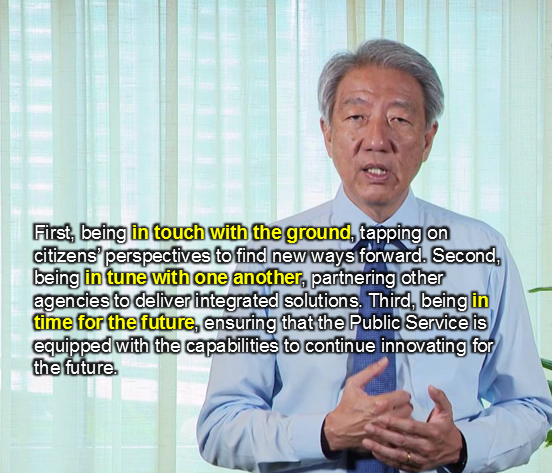The 13th China-Singapore Joint Council for Bilateral Cooperation Meeting, the 18th China-Singapore Suzhou Industrial Park Joint Steering Council Meeting, the 9th China-Singapore Tianjin Eco-City Joint Steering Council Meeting, and the First China-Singapore (Chongqing) Demonstration Initiative on Strategic Connectivity Joint Steering Council Meeting were held on Feb 27 in Beijing.
DPM Teo Chee Hean co-chaired the meeting with Chinese Vice-Premier Zhang Gaoli.
Mr Zhang is a member of the Communist Party’s apex Politburo Standing Committee which currently has 7 members and is the most powerful decision-making body of the party.
The 13th JCBC meeting reviewed bilateral cooperation in the areas of economic transformation, finance, people-to-people exchanges, and inclusive and sustainable development.
The co-Chairs identified the “Belt and Road” initiative as a new and significant area of bilateral cooperation. Both sides agreed to explore opportunities for partnerships between Singapore and Chinese companies venturing into regional markets, given Singapore’s position as a strategic hub for trade, transportation, finance and project management along the Maritime Silk Road.
“China places high importance on developing ties with Singapore and wishes to work together with Singapore to deliver on the various agreements between the leaders, enhance political trust, strengthen strategic cooperation, build closer people-to-people ties and deepen bilateral cooperation.”
- China’s state media Xinhua said in a report on Mr Zhang’s meetings with Mr Teo.
DPM Teo and Vice-Premier Zhang Guoli at the 13th JCBC Meeting.
9th Singapore Tianjin Eco-City Joint Steering Council Meeting co-chaired by
DPM Teo Chee Hean and Vice-Premier Zhang Guoli
RSN's port call at Qingdao, 23 - 26 April 2017
The Republic of Singapore Navy (RSN)'s Formidable-class frigate, RSS Intrepid, made a port call in Qingdao, China from 23 to 26 April 2017 and received a rousing welcome from the Chinese Navy and their military band.
A ROUSING WELCOME FROM THE CHINESE NAVY AND THEIR MILITARY BAND AT QINGDAO
SENIOR-CAPTAIN LI JUN FROM PLA (N) WELCOMED SENIOR LIEUTENANT TAN BIAN
Inaugural International Maritime Review, 15 May 2017
Chinese sailors aboard the guided-missile frigate Huangshan man the rails during maritime review in waters
off the Port of Changi in Singapore, May 15, 2017. (Photo by Xu Guang)
While the Obor forum was being held, 28 warships from 20 countries gathered in Singapore, including China's Huangshan frigate, and the Chinese delegation was led by Rear Admiral Zhou Xuming, deputy commander of the South China Sea Fleet of the PLA Navy.
As part of RSN's 50th anniversary celebrations, the RSN hosted Singapore's inaugural International Maritime Review (IMR) on 15 May 2017 to welcome friends from around the world to join them in their 50th anniversary celebrations.
6th Singapore-China Forum on Leadership themed “Leadership Development for National Innovation (国家全面创新中的领导力建设)” - held in Singapore on 16 May 2017
The leadership forum was co-chaired by DPM Teo Chee Hean, and Member of the Political Bureau and Minister of the Organisation Department of the Communist Party of China (CPC) Central Committee Mr Zhao Leji.
The political bureau is made of up 25 members and they are the important members of the CCP.

While in Singapore, Minister Zhao called on Prime Minister Lee Hsien Loong.
Next month...
An exclusive report by Lianhe Zaobao last Thursday said that the third round of talks on the upgrade of the Singapore-China Free Trade Agreement will be held in Beijing in the middle of next month.
The news was confirmed by the Chinese embassy in Singapore. It is understood that the "upgraded version" of the "real stuff" included removing more obstacles for Singapore enterprises investing in China and providing them with more protection.
So how are ties between China and Singapore?
We are on the right track.
As Deputy Prime Minister and Coordinating Minister for National Security Teo Chee Hean said at the East Asian Institute's 20th anniversary celebrations last Wednesday:
"Our common interest in building a peaceful and growing region is much greater than any occasional differences of views. Singapore will continue to be a strong and principled supporter of China's peaceful development and constructive engagement in the region."
National Development Minister and Second Finance Minister Lawrence Wong, who represented Singapore at the recent Obor forum, had said that Singapore is a financial centre, and 60 per cent of the earlier Obor projects implemented in Asean came from Singapore.












